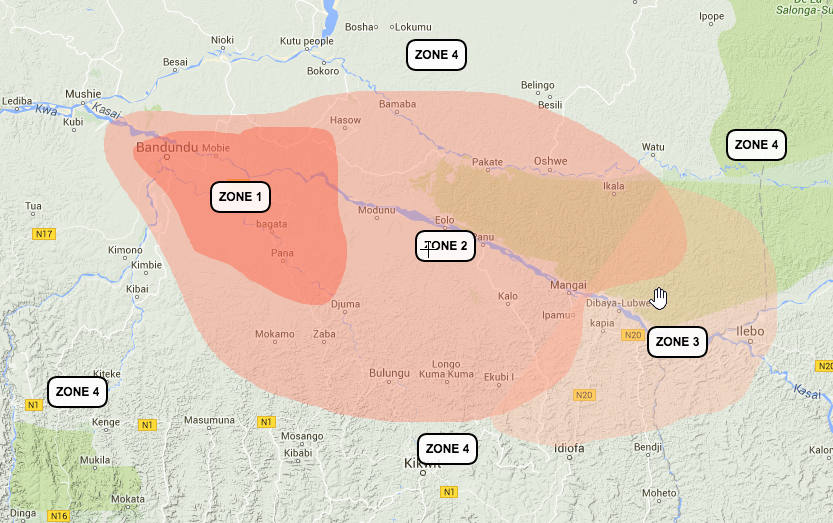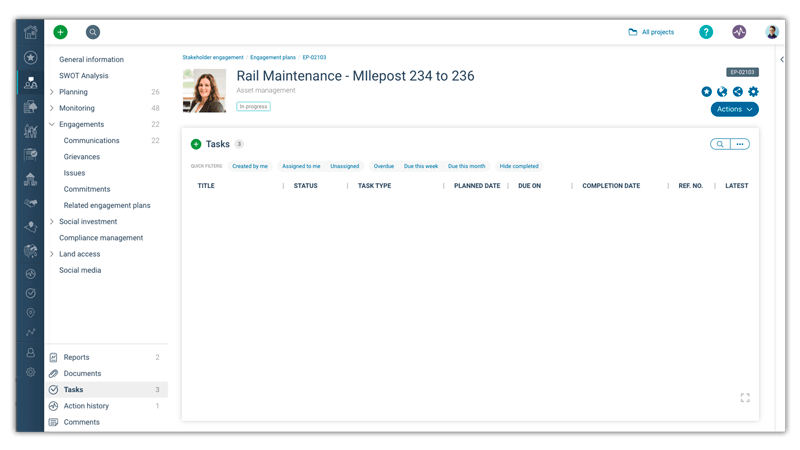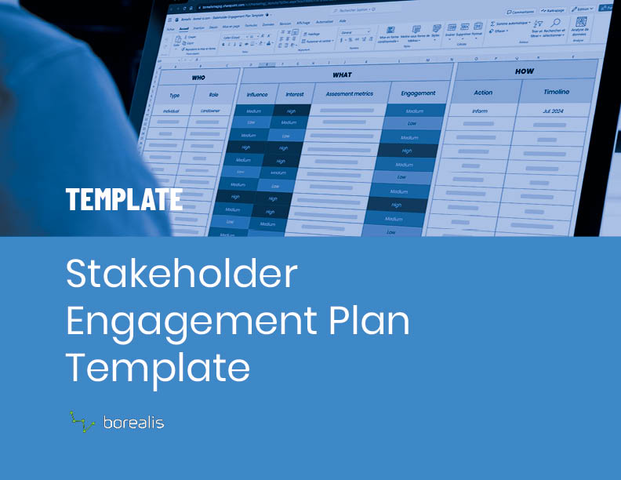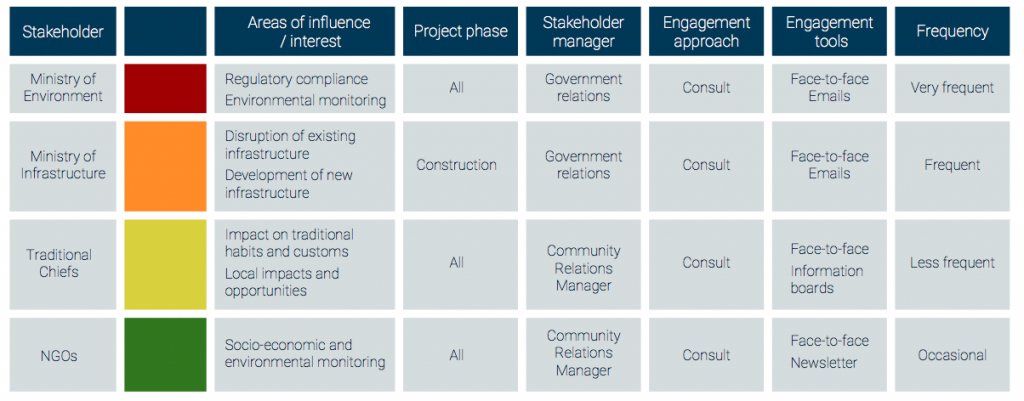When it comes to effective on-site and remote project management, one key aspect is an effective communication plan. Though planning is daunting, it can make the difference between your project’s success and failure. It is especially critical when your project impacts many stakeholders—who may have positive or negative feelings about your project.
It’s what makes stakeholder engagement planning so essential. A stakeholder engagement plan considers every individual, organization, business, family, governmental institution, indigenous group, piece of land, tree, crop, animal, that will be affected by the scope of your project. That may sound like a lot of stakeholders, but some projects do involve that level of detail.
While communities are different everywhere, there’s one thing that’s common to all: if you voluntarily keep them out of the decision process, refuse to inform them of plans, and let misinformation spread, it’s only a matter of time until you lose social acceptance. Improving community relations practices helps ensure stakeholders view your project positively.
Planning stakeholder engagement won’t guarantee your social license to operate, but it will give you a tremendous head start. Of course, you can’t plan it all. A natural disaster could strike, or funding could fall through. There’s a lot beyond your control. Fortunately, managing unplanned crises and events will be much easier if you have a good stakeholder engagement plan.
What is a Stakeholder Engagement Plan?
A stakeholder engagement plan is all about strategic communication. It is a step-by-step process outlining how your organization will communicate with your stakeholders to increase the likelihood of positive project outcomes.
It is a written document that identifies key stakeholders and outlines your approach to interacting and communicating with them. It allows your project manager to devise a method to manage expectations and deliver the right information to the right people at the right time.
A stakeholder engagement plan is closely linked to stakeholder analysis. They both aim to help you decide which types of communication and messaging will be most successful. This can help you minimize negative perceptions, amplify positive impacts, and resolve conflicts before they escalate.
How to prepare a Stakeholder Engagement Plan (SEP)?
Stakeholders have the power to influence your project, so a proactive communication strategy will help deliver positive project outcomes. Completing your stakeholder engagement plan before your project kickoff is the best practice. The plan provides structure, clarity and timeliness to your communications and engagement. Your initial plan will help you start, but it is a starting point. As the project evolves, you’ll need to update your plan frequently.
Of course, no two projects are alike. Each project has several engagement plans open at the same time. Each will address different groups of stakeholders and different aspects of the project. You’ll constantly need to evaluate communication strategies to consult with diverse groups to gain and maintain their support to increase the likelihood of a successful project.
Our experience has proven that a good stakeholder engagement plan consists of should 12 sections.
1. Areas of influence
This first section provides a geospatial understanding of the areas impacted by the project. It also determines the level of engagement according to each zone. For example, let’s say that your project has four zones, which you’ll find on the following map:

Zone 1: Significant
This zone is the closest to the project site and will frequently impact stakeholders, potentially daily.
Zone 2: Moderate
Zone 2 stakeholders often deal with the project. Impacts are not as significant as in Zone 1, but they are still important.
Zone 3: Minor
The stakeholder’s interactions with the project are limited or restricted to a specific project phase.
Zone 4: Negligible
Interactions could occur on an incidental or occasional basis with stakeholders in this zone, and impacts are either very limited or nonexistent. Here’s how one could map the zones:
It’s a good idea to prepare the first version of the map before implementing the engagement plan. Remember that you’ll readjust zones as the project evolves through its lifespan
2. Regulations and requirements
INTERNAL
- Code of business conduct and ethics
- Anti-bribery and corruption policies
- Privacy policy
- Risk management policy
EXTERNAL
- Local, regional and national regulations
- International standards
- World Bank (IFC)
- Free, prior and informed consent (FPIC)
- Global Reporting
- Initiative (GRI)
- International Council on Mining and Metals (ICMM)
- Extractive Industry Transparency Initiative (EITI)
In some contexts, online engagement tools help you better map the current stakeholder landscape. This lets you leverage data to shape a more solid engagement strategy and be on top of what is happening. As conversations in the community occur, you’ll want to understand how people perceive your project.
However, effective engagement entails more than simply identifying stakeholders and letting them voice their concerns; it also requires taking the appropriate actions. And these actions must always be in line with the organization’s goals while respecting key stakeholder concerns.
Sooner or later, you’ll want to address the concerns raised online. You may wish to interact personally with critical stakeholders. You’ll also need to organize all interactions, problems, new issues, and stakeholder contacts in a central platform.
Also, you don’t want to open yourself to people trolling your online engagement platform and sowing confusion about your project. It’s important to consider appointing someone to moderate the information people are sharing online to avoid this risk.
3. Methodology
Government Authorities
- Local authorities
- Ministries
- Public advisory bodies
Advocacy Groups
- Civil Society & Development Agencies
- Environmental groups
- Nongovernmental organizations (NGOs)
- Religious authorities
Affected Communities
- Inhabitants of areas affected by the project
- Representatives of affected people
- Job seekers
Commercial Organizations
- Local businesses
- Local providers (services and products)
- Associations
- Unions
Stakeholder identification doesn’t end here. Further analysis is vital to ensure your plan is as complete as possible. Among other things, it’s important to identify vulnerable people.
Another critical aspect of the methodology is categorizing issues. Not all stakeholders will be affected by the same impacts, and classifying them according to the issue will simplify managing these various issues. Plus, you’ll easily identify which problems need your team’s attention. Categories may include social, health and safety, environment, economic, and security. These categories can also be divided into sub-categories to provide an extra level of clarification. For example, the environmental section could have “air quality” and “waste management” as sub-categories.
Create a solid stakeholder engagement plan to secure the social acceptance of your project.
4. Project stakeholders
This section of your Stakeholder Engagement Plan is an extensive list of every group and sub-group you defined in your methodology. You’ll include details such as traditional and customary authorities, villages, etc. For longer lists like Project Affected People (PAP), you can add them in an appendix – as they will be quite long.
Identifying and categorizing your stakeholders is one thing but understanding them is different. Stakeholder mapping helps you understand each stakeholder according to parameters like influence/power capacity, network capacity, and interest level.
Sometimes, stakeholders with high interest have little to no influence among their peers. Of course, you’ll still need to engage with them, but you’ll want to spend much more time engaging with those stakeholders who have a lot of influence and who are interested in your project.
In some instances, you’ll want to reach out to stakeholders with high power capacity. Your initial stakeholder mapping will change and evolve as you learn more and as the situation changes.
Here’s an example of a stakeholder map:
5. Stakeholder Engagement activities
The “activities section” of your stakeholder engagement plan defines your communication strategies for each group you identified during your stakeholder analysis. In other words, this section is your communication strategy.

Activities included in this section of your plan include:
- defining your audience
- identifying communication tools, such as:
- public meetings
- email campaigns
- focus groups
- in-person visits
- conferences
- traditional mail
- determining the frequency of your planned interactions and communications
- outlining the tools you’ll use to efficiently implement your strategy to implement your strategy efficiently
It’s essential to keep in mind the project lifecycle as you plan communications, as some steps require more engagement than others. For example, during the construction phase, you might need to hold monthly focus groups with stakeholders from villages A and B.
Stakeholder engagement software with an Engagement Plan Feature can be of immense help. It allows teams to easily coordinate, prioritize and report on activities, demonstrate compliance with regulatory requirements, visualize assets, hot spots and rising issues, and generate an institutional memory to empower future engagement efforts. The software allows you to use these valuable insights, not only for a specific project, but also to obtain a long-term view of your strategic stakeholder engagement.
By centralizing all this carefully collected data in a single platform, this valuable information will always be at your fingertips – and displayed in a meaningful way. And as we all know, having access to the right information at the right time is the key to good decision-making.
6. Stakeholder engagement plan template
Get ready for the biggest section of your plan! Now that we’ve identified who your stakeholders are and how you’ll reach them, this section of your stakeholder engagement plan will cover how to implement your strategy.
To understand this sample stakeholder engagement plan template, please refer to the stakeholder map in the methodology section, above. Once again, this matrix should separate each stakeholder group (Authorities, Affected communities, etc.) We’ve added a stakeholder for each quadrant in the following chart:

Creating a solid stakeholder engagement plan is crucial for effective project management.
7. Timetable
8. Resources and responsibilities
As you begin to coordinate activities, be sure to clearly outline each team member’s responsibilities. Who is responsible for what? Who will lead? What is the hierarchy for grievance escalation?
It’s good practice to create a detailed job description for each position, including the names of the people who are in charge. You can even add an organizational chart to provide a visual overview of roles. If your project involves external contractors or consultants, in addition to regular employees, make sure you indicate the nature of their role along with their position.
9. Grievance management
According to the IFC handbook, Stakeholder Engagement: A Good Practice Handbook for Companies Doing Business in Emerging Markets, companies should not only have a grievance mechanism process, but they should also put it in writing and publicize it, respond in a transparent and timely manner, and keep good records, and report back.
Stakeholders should be able to request and receive a clear definition of what constitutes a grievance and how it is managed, including an estimated resolution time. If you’d like to learn how to implement an effective grievance mechanism, this white paper explores the topic in-depth.
10. Monitoring and reporting
Congratulations! Your plan is almost complete. As you begin to interact with stakeholders, you’ll need to monitor and report on your engagement activities.
There are many ways to do this. Basic approaches typically involve using a combination of Excel spreadsheets, email and shared documents, etc. But since this patchwork of tools tends to compromise data security and traceability, they’re inefficient for monitoring and reporting purposes. That’s why experienced stakeholder engagement teams will opt for the added productivity and transparency that comes with using a stakeholder relationship management system (SRM).
There are many advantages to using an SRM to manage stakeholder engagement. First, all data is centralized in the same place – a huge time saver when you’re looking for specific information from an interaction that took place two years ago.
Some systems also offer advanced analytical tools to help you quickly compile reports and extract meaningful insights from your data. In addition to knowing how many grievances you’ve had over the past 18 months, you can access more details like areas, subject, and resolution time in just a few clicks. Or generate a monthly report of your team’s engagements with trends in just a few clicks. The right system will let you do all that and much more.
And that’s what Borealis stakeholder engagement software offers. We go beyond planning by providing the software that lets you break your engagement plan down into a series of actionable activities and assign tasks to your team. The Stakeholder Engagement Plan feature It gives you a real-time view of your progress as the project unfolds which allows you to quickly adjust course as needed. Proper planning will help you minimize oversights, eliminate duplicate efforts, and simplify the reporting process.
If you’d like to know more about our system and how it facilitates the monitoring and reporting of your stakeholder engagement activities, contact us. We’ll be happy to discuss how Borealis software can support your project.
11. Budget
12. Appendix
The Appendix is where you’ll include any documents such as your list of PAP, grievance form templates, public consultation attendance sheet template, etc. You may also find it helpful to link to any other documents that might be relevant to your stakeholder engagement plan.
We hope these tips will facilitate your work and provide a valuable framework for building a solid stakeholder engagement plan!
Importance of the Stakeholder Engagement Plan
Stakeholders have tremendous sway over the project’s success. A stakeholder engagement plan is the foundation for achieving a proactive communication strategy. It is a significant undertaking. Each stakeholder has varying needs and wants. Your plan should outline the communication and consultation requirements of each person (or group of people) impacted by your project.
We’re here to support you with the software you need to create an effective plan. But, we’re about more than software. We’re here to become a trusted partner, providing the training and advice that you need to help support your projects.








